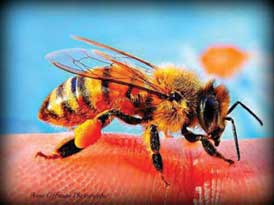
Words from the Hive: The ladies are back to full-time work
by Christine Hrenya, Ph.D. Engineering
Please join us for our next monthly Gallatin Valley Beekeepers club meeting on Monday, April 16th from 6–7:30pm at Bozeman Public Library. Doors open at 5:30pm for networking. The event is free and open to all. In April, our new bees are arriving and it is time to open our existing hives. This club meeting will focus on setting up your apiary, cleaning out dead hives, rotating brood boxes, and how to hive new packages and nucs. In conjunction with several other Montana clubs, we will be conducting experiments on the various mite treatments and IPM (integrated pest management) strategies. If you have experience beekeeping and would like to mentor a newbee, please come and meet new beekeepers who would love your insight or even just watch you do what you do.
For up-to-date information on local beekeeping events, see “Gallatin Valley Beekeepers” on Facebook or email GallatinValleyBeekeepers@gmail.com.
What the honeybees are up to…
The Bozeman hive experiences a surge in activity in April compared to the winter months. Each female bee has a job to do and an incredible work ethic. The same is not true for male bees, or drones, but there aren’t any in the hive just yet – it is still ladies only. Stay tuned for more on these lazy boy bees in May.
In April, the queen bee resumes her life’s mission as an egg-laying machine, with 1000–2000 eggs laid per day. All the remaining ladies are worker bees (cue sigh from female readers). Job titles change with age. The queen bee does not want her workforce to get stuck in dead-end jobs, and instead promotes lifelong learning and career development.
So what are the jobs of worker bees? The “queen’s court” of worker bees continuously feed and groom the queen. Nurse bees tend to the larvae (pre-bee) and feed the baby bees, which hatch after 21 days. Cleaner bees scrub down the house. Builder bees construct honeycomb. HVAC bees ventilate the hive by flapping their wings and cool the hive by evaporating water. Undertaker bees remove dead bees from the hive. Guard bees keep watch at the entrance, and gang up on robber bees that come to steal their honey. Forager bees collect early sources of pollen, which the baker bees transform into beebread. That’s right, baker bees add their digestive fluids to pollen, which enables fermentation into beebread – a protein-rich superfood for baby bees!
What the beekeepers are up to…
April is a busy month for both hobbyists and commercial beekeepers. The migratory beekeepers and their bees are now back in Montana. Those starting new hives are finalizing their apiary equipment and installing new bees. Those with existing hives are lifting the lid to check on viability, supplementing with food as needed (sugar for carbohydrates source and pollen for protein), inspecting for disease and pests and treating if necessary.
What the non-beekeepers can do…
Interested in supporting the viability of honeybees without keeping a hive of your own? Then feed the bees! As good cooks know, content, timing, and presentation all matter. What to feed, you ask? Bees get their protein and sugar from the pollen and nectar, respectively, of blooming flowers – this is their feed. When to feed? Whenever it is warm enough to fly out of hive, typically April through October. August and September are especially critical, since the bees are storing up food for the winter months when it is too cold to leave the hive: think asters, Russian sage, coneflowers, lavender, borage, mint and sainfoin. And come on, do bees really care about presentation, you ask? Yes! Their favorite colors are what we see as blue, purple, yellow, and white. Bees cannot see some colors, like red. But unlike humans, bees can see ultraviolet light, giving rise to eye-catching “bullseyes” of nectar and pollen that are invisible to humans. The dandelion photo indicates what we see (right) and what honeybees see (left).
For more information on planting a pollinator garden with a sequence of blooms throughout the summer, see www.montana.edu/pollinators/resources.html and www.bigskybees.org/BeeFriendlyFlowers.html.
Gallatin Valley Beekeepers is a nonprofit whose objective is to serve as a resource to local beekeepers, to educate the members and community about the science, art, and benefits of beekeeping, and to foster communication and cooperation between beekeepers and the community at large. •







